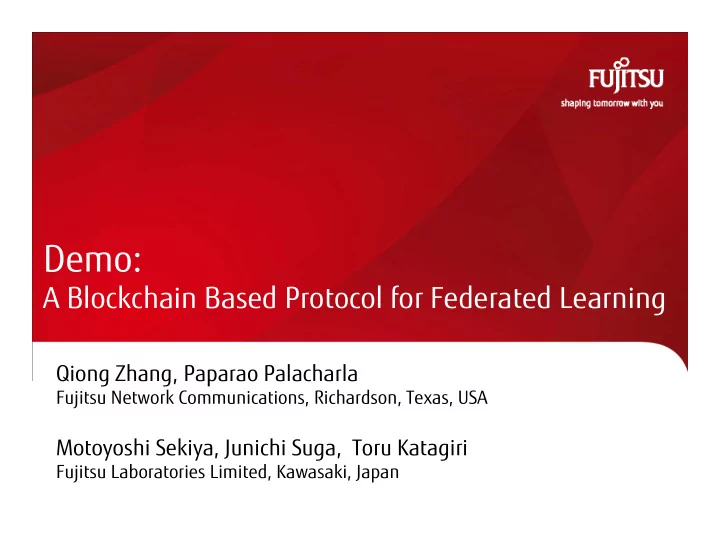

Demo: A Blockchain Based Protocol for Federated Learning Qiong Zhang, Paparao Palacharla Fujitsu Network Communications, Richardson, Texas, USA Motoyoshi Sekiya, Junichi Suga, Toru Katagiri Fujitsu Laboratories Limited, Kawasaki, Japan
Federated Learning (FL) FL is a distributed Machine Learning (ML) approach which enables ML models training on decentralized private data FL usually involves a central server and a group of clients FL can have hundreds of training rounds when converged FL server aggregates received local models from clients, e.g., weighted avg. Clients get the global model and local model: x1 local model: x2 train it with local data, then #training samples: p1 #training samples: p2 provide local model to the server FL FL 2 Client Client 3 1 FL Server A FL server sends a The server gets local global ML model to a models and Aggregated global model: x0 group of clients aggregates them to a x0 = (x1 · p1 + x2 · p2)/(p1+p2) global model Three steps in a single training round FL sever aggregation
Challenges in Federated Learning Focus on cross-silo FL Organizations act as FL server/clients and share a common incentive to train a model based on all of their data FL server and clients are physically distributed at different organizations FL Client FL Server FL Client FL Server Secure network communications Authentication Tracking P. Kairouz, et. al., “Advances and Open Problems in Federated Learning,” https://arxiv.org/abs/1912.04977
Blockchain for Data Exchange Fujitsu’s technology applying blockchain to enable secure data exchange VPX: Virtual Private digital eXchage metadataPublish() Data FL Client Local Local Metadata FL Client training model for local model Blockchain recording metadata dataGet() metadataGet() ML Model = Data FL Server J. Suga and Q. Zhang, “Cross-Organizational Secure Data Exchange with Access Control using Blockchain,” presented at Hyperledger Global Forum https://www.youtube.com/watch?v=YyKEQqxzBJI, March 2020.
Proposed Blockchain-based Protocol for FL At FL Clients: 2. metadataGet()- read metadata from the blockchain 3. Check if a new global model is available. If no, go to step 2. If yes: 4. dataGet() – get the global model from the server 5. Local training on the local data set 6. metadataPublish() – write metadata for the local model update to the blockchain; go to Step 2 FL FL Client Client FL Server At the FL aggregation server: 1. metadataPublish() – write initial global model metadata to the blockchain 7. metadataGet() – read metadata from the blockchain 8. Check if # available local models meets a threshold. If no, go to Step 7. If yes: 9. dataGet() – get local model updates from the selected clients 10. Aggregate local model updates to a new global model 11. metadataPublish() – write the global model metadata to the blockchain; go to Step 7 Only the metadata of ML models are written to the blockchain, the actual models are directly transferred between FL server and clients
Advantages Track FL training steps with immutable records on the blockchain Transfer only selected ML models between FL server and clients Consensus (metadata) on blockchain indicate the availability and quality of ML models Enable client selection without transferring unnecessary local models to the server Simplify the underlying network configurations for FL Take advantage of security features provided on the blockchain platform
Demo Configuration Blockchain Network NN model training on MNIST FL Client1 NN Model NN Model Metadata FL Server NN Model FL Client2 VPX Server ML Server
Recommend
More recommend